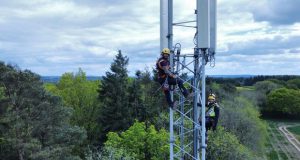Switchtec’s Jeremy Lester explains the potentially disastrous impact of lightning and other disruptive events on LED street lighting, and how the sensitive components can best be protected
Outdoor lighting systems are subject to a variety of permanent, temporary or transient electrical disturbances. These events represent a considerable threat to the equipment connected to these networks. The age and often degenerative state of the networks aggravate the problem.
The threats are numerous and include lightning strikes and its secondary effects, switching overvoltages, network distribution problems – such as loss of neutral or connection errors – and harmonic voltages. Although these disruptions can occur on external networks, historically the equipment connected to them was usually robust enough to tolerate the effects without incident. However, the introduction of complex electronic technologies on these networks has exacerbated the problem.
Disruptions are becoming a major and a real threat. An excellent example of this is the change in recent years to LED technology in the outdoor street lighting market.
MAJOR HAZARDS
There are many potential problem areas when considering outdoor lighting systems. They include very sensitive equipment (electronic drivers, LED components), connection to disrupted networks, very long supply connections, and large quantities of equipment dispersed externally. This means that LED equipment will be subject to various disruptions that may seriously affect its performance and service life – ironically, given that long service life was a major argument for switching to LED technology.
Transient overvoltages due to lightning is a well-known hazard resulting from lightning strike effects on the distribution networks, including strikes on overhead lines, ground potential rise, and electromagnetic radiation on the networks. The scenarios are numerous and will create very high amplitude transient overvoltages (several kilovolts) that are fatal to sensitive components and equipments such as LED lights.
Electrical networks are full of inductive loads that can generate transient overvoltages of up to several kilovolts. A major source of switching overvoltages in outdoor lighting networks are the ferromagnetic power supply modules for discharge lamps that are used in LED lighting. Each start-up creates the impulse overvoltages that can find their way to the fragile LED equipment.
A connection error (phase/phase connection) or a neutral failure on the supply network will generate almost twice as much AC voltage to the equipment. These temporary overvoltages are devastating for the connected equipment.
The active loads on the networks generate harmonic disturbances that lead to faults and are the cause of premature ageing of electronic circuits. In lighting circuits, discharge lamps and other neon tubes are powerful harmonic generators.
These phenomena are not linked to the quality of the distribution network but directly to the specific construction of the LED luminaire, and are a proven cause of system failures. Most of the outdoor luminaires in a few European countries are manufactured as class II (protection against indirect contact by double insulation or reinforced insulation). These have a metal casing that contains the equipment and is not connected directly to the protective earth (PE), nor is it indirectly connected via a conductive support.
A typical example is a lamp on a wooden or fibreglass mast. There is a risk that the metal casing will be electrostatically charged by the wind – friction with dust particles – with no facility to discharge it. This electrostatic charge can reach high voltages (kV), and in certain conditions transfer its energy to internal components.

Now that the sensitivity of external LED lighting systems to surge voltages is known, solutions must be provided. One possible answer is the use of reinforced drivers to withstand the high surge voltages. Some LED luminaire manufacturers are beefing up their drivers with the ability to withstand 8 to 10kV in impulse voltage (1.2/50micro seconds waveform). However, even if this method strengthens the LED luminaire, it is not as effective as a solution that includes an external surge protector.
There are various options, but the best solution is use of an external surge protection device as it is able to withstand the worse case scenario – a 20kV surge voltage – while easing the maintenance process.
Surge protection devices (SPDs), also known as transient voltage surge suppressors (TVSS), for low voltage networks are a mature, reliable and standardised technology (NF EN 61643-11). They are very effective at providing protection against voltage transients such as lightning and switching surges. A good supplier should be able to offer versions suitable for use in luminaires to be fitted either in the junction box at the foot of the mast, or integrated into the head of the luminaire.
In certain technical guides used in Europe, the need to use SPDs is integrated (rules for the installation of external low-voltage networks) and is based on a simplified risk analysis. SPDs should also be integrated into the control cabinet as well as the supervisory/control networks when applicable.
For protection against temporary overvoltages and loss of neutral – potentially very damaging – there are special SPDs designed to sacrifice themselves (controlled end-of-life mode) and disconnect the terminal equipment to protect it. Another option is to use an industrial frequency overvoltage protective device, such as Citel’s VM230.
Eliminating the risk of electrostatic charge in class II luminaires should be addressed during manufacture. However, corrective or complementary action can be undertaken using specific discharge devices, sometimes included in surge protection devices. Citel’s MLPC2-230L-R/ESP is an example.
The rapidly changing technology of equipment installed in outdoor lighting networks poses serious risks in terms of reliability. To ensure continued operation and the expected service life, it is critical to understand the distributed nature of these systems, their vulnerabilities and the very specific protective measures that are required.




